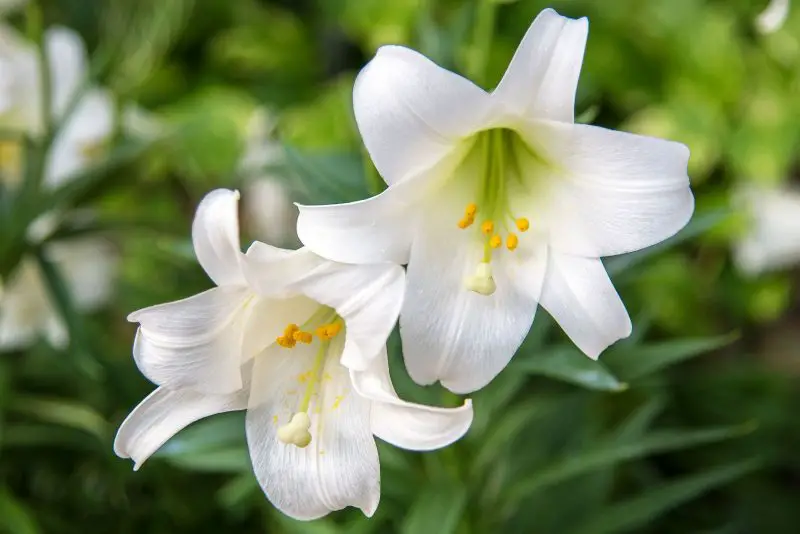What are Easter Lilies? Easter Lilies (Lilium longiflorum) are elegant, trumpet-shaped flowers most commonly seen in pure white. They bloom around the Easter holiday and are widely used in homes, churches, and celebrations to symbolize purity, hope, and resurrection. Their cultural and religious significance makes them one of the most cherished spring flowers.
Though many associate them strictly with Christian traditions, Easter Lilies have a fascinating origin. They are native to the Ryukyu Islands of Japan and were introduced to the United States in 1854. Since then, they have become a popular seasonal plant and an important symbol of renewal and new beginnings.
The Symbolism Behind Easter Lilies
Easter Lilies are rich in symbolism. In Christian faith, the flower is linked to the resurrection of Jesus Christ and is often seen as a representation of his purity and promise of eternal life. The white petals symbolize virtue and innocence, making them ideal for Easter services and springtime displays.
Different colors, though rarer than white, also hold unique meanings. Pink Easter Lilies signify femininity and grace, lavender lilies represent enchantment, and yellow lilies symbolize joy and gaiety. No matter the color, they are a reminder of life’s beauty and spiritual awakening.
Are Easter Lilies Perennials?

Yes, Easter Lilies are true perennials. With the right care, they can bloom year after year, making them more than just a one-time decorative plant. After their spring bloom, the plant’s foliage continues to support the bulb underground, storing energy for the following season.
To grow Easter Lilies as perennials, plant them in well-drained soil with access to full sun or partial shade. They thrive in USDA hardiness zones 5 to 8. Once the blooming period is over, allow the foliage to die back naturally before cutting it down. This resting phase is essential for future blooming.
Can Easter Lilies Survive Winter?
Easter Lilies can survive winter—but only under certain conditions. These flowers are not frost-hardy and require protection in colder climates. In areas with mild winters, the bulbs can remain in the ground. However, in colder zones, gardeners should dig them up and store them in a cool, dark place indoors.
To overwinter Easter Lilies successfully, reduce watering in the fall, stop fertilizing, and move any potted lilies indoors when nighttime temperatures fall below 50°F (10°C). Store them in a well-ventilated garage or basement until the next spring planting season arrives.
Are Easter Lilies the Same as Daffodils?
Although Easter Lilies and daffodils bloom around the same time and are often associated with Easter, they are completely different flowers. Easter Lilies belong to the Lilium genus, while daffodils belong to the Narcissus genus.
Easter Lilies have long, trumpet-shaped blooms with a delicate fragrance, typically in white. Daffodils, on the other hand, feature a central trumpet surrounded by petal-like tepals and come in shades of yellow and white. Symbolically, Easter Lilies represent purity and resurrection, while daffodils are a broader emblem of rebirth and new life.
Are Easter Lilies Toxic to Cats?
Yes, Easter Lilies are highly toxic to cats. Even a small amount—such as licking pollen from their fur or nibbling a leaf—can lead to serious kidney damage or even death. Symptoms usually appear within 6 to 12 hours and include vomiting, loss of appetite, lethargy, and dehydration.
If you suspect your cat has come into contact with any part of an Easter Lily, contact a veterinarian immediately. Prompt treatment is essential, and many cats can recover fully with early intervention. For households with pets, it’s safest to avoid bringing these plants indoors or opt for pet-safe alternatives.
Popular Varieties of Easter Lilies
There are several popular varieties and related hybrids often grouped with Easter Lilies, each with their own charm and bloom characteristics:
Casa Blanca Lily
This hybrid variety features large, pure white flowers with a strong, sweet fragrance. It is prized for its classic beauty and is frequently used in floral arrangements.
Stargazer Lily
Although not a true Easter Lily, the Stargazer is often used during Easter for its vibrant pink and red petals edged in white. Its bold colors and strong scent make it a standout in gardens and bouquets.
Madonna Lily
An older, heirloom type of lily with white blooms and yellowish-green streaks. It has a softer fragrance and a historical association with purity and the Virgin Mary.
Tiger Lily
Known for its striking orange petals with dark spots, the Tiger Lily is not traditionally used for Easter but is sometimes grouped with lily varieties because of its bold, cheerful look.
Pollinators That Visit Easter Lilies
Easter Lilies attract several types of pollinators, including bees, butterflies, and hummingbirds. Their large, open blooms and fragrant scent make them ideal landing spots for pollinating insects.
These pollinators help transfer pollen from one bloom to another, aiding in seed production and the plant’s long-term survival. For gardeners looking to create pollinator-friendly spaces, Easter Lilies are a beautiful and beneficial choice.
Are Easter Lilies Indoor or Outdoor Plants?
Easter Lilies can be grown both indoors and outdoors, depending on your climate and preference. Indoors, they are typically grown in pots during the Easter season and then transplanted outside once the bloom fades.
When kept indoors, place them in a bright location away from direct heat sources. Water regularly to keep the soil lightly moist. Outdoors, plant them in full sun or partial shade with well-drained soil. With proper care, they will bloom reliably each spring and become a recurring feature in your garden.
How to Care for Easter Lilies
Caring for Easter Lilies involves a few key steps to keep them healthy and thriving:
-
Light: Provide full sun or partial shade. Indoor plants need bright, indirect light.
-
Watering: Keep the soil consistently moist but not soggy. Avoid overwatering.
-
Soil: Use well-drained, fertile soil enriched with organic matter.
-
Fertilizing: Use a balanced liquid fertilizer during the growing season, but stop once the blooms fade.
-
Deadheading: Remove spent blooms to encourage energy storage in the bulbs.
-
Post-Bloom Care: Allow the foliage to yellow and die back naturally before cutting it off.
Conclusion
Easter Lilies are more than just decorative flowers—they are a timeless symbol of hope, purity, and new beginnings. Whether you’re wondering “What are Easter Lilies?” or looking for tips on growing and caring for them, these blooms are sure to bring elegance and spiritual meaning to your garden or home.
From their sacred symbolism to their beautiful appearance and perennial nature, Easter Lilies are a beloved part of the spring season. With proper care, they can brighten your space year after year, making them a worthy addition to any flower lover’s collection.






